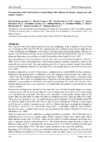Please use this identifier to cite or link to this item:
https://accedacris.ulpgc.es/jspui/handle/10553/114778
| Title: | Characteristics of the shelf at Gran Canaria island, with evidences of tectonic, volcanic and sedimentary features. | Authors: | Echevarrieta Legrand, L. Masdeu Navarro, M. Sánchez García, María José Alonso Bilbao, Ignacio Castro Rodríguez, M.A. Hernández Acosta, C.N. Melián Ramírez, Abisai Santiago Villalba, J. Santos Bethencourt, R. Suárez González, E. Montoya Montes, Isabel |
UNESCO Clasification: | 2506 Geología 250621 Vulcanología |
Issue Date: | 2014 | Conference: | IV Congress of Marine Sciences | Abstract: | Gran Canaria is one of the central islands of the Canary archipelago. It has a diameter of about 45 km and it is located at 28ºN and 15º35’W. The subaerial part of the island has been formed within the last 15 My (McDougall and Schmincke, 1976) during three major magmatic/volcanic phases. The first one began during the Miocene (14 My), the second one during the Pliocene (4 My) and the third one occurred during the Quaternary, centered this one in the Northern part of the island (Ye et al., 1999). Due to its young age, it has to be expected that the island shelf will not be much developed (Criado et al., 2002). For this reason, the northern part of the island, principally formed by Quaternary eruptions, has practically an inexistent shelf. The continental margin of Gran Canaria is mainly formed from turbidity currents and hemipelagic deposits, but avalanche flows and volcanic material can also be found (Acosta et al., 2005). In order to characterize the shelf of Gran Canaria, a digital elevation model (DEM) has been generated. Bathymetric data proceed from two different sources: the bathymetry from 0 to 50 m with isolines each 1 meter from the “Estudio Ecocartogra´fico de Gran Canaria” (MMA, 2002a, 2002b), while bathymetric contours from 100 to 600m were digitalized from “Repositorio de Datos Marinos Integrados de Canarias (REDMIC)” (www.redmic.es). The DEM of the shelf was performed with ArcGis 10.1 software. Three different information layers were constructed: the shaded relief, the gradient (slope) and the last layer with the isobaths. Based on the resulting layers, the limit of the island shelf was established from the change in the slope, so that the areas with the slope lower than 4% were considered part of the shelf, while steeper slopes were considered out of the shelf. This limit is very reasonable considering the volcanic origin of this island. Once the outer limit was fitted, the shelf was divided in two main areas according to its width. These areas are separated by two very significant geographical elements: Punta de Sardina in the NW and Punta de Gando in the E. The shelf between these two points through the N-NE has a coastal length of 82.7 km and its width is extremely narrow (2650 m). On the other hand, the island shelf though the W-S-SE has a coastline of 126.1 km and the average width is much higher (7800 m). Such difference between both areas is related to the isostatic uplift generated by the island of Tenerife 3.5-3.8 My ago (Mene´ndez et al., 2008). These two main areas can be subdivided according to platform singularities. The N-NE shelf can be subdivided in two areas of very similar length. Firstly, a northern region, where shelf reaches 100 m depth and the average width is 2740 m. Along this area different volcanic structures can be identified, such as submarine volcanic cones and lava flows. The second subsector ranges between La Isleta and Punta de Gando, and it is characterized by an average shelf width of 2560 m and the outer limit goes down to a medium depth of 90 m. The slope is quite constant from the coast to the shelf limit. Regarding the W-S-SE shelf, it can be also subdivided in three main sectors. The SE sector, from Gando Point to Maspalomas lighthouse (44.4 km coastline), where the shelf is much wider than the previous zones. It has a regular slope with a medium width of 6450 m and a standard depth of 100 m. The Southern sector is the smaller one, since it only covers 15.7 km of coastline, from Maspalomas lighthouse to Anfi resort. It is characterized by Pasito Blanco sandbank, whose average depth is about 20 m. This sector is clearly related to sedimentary deposition processes. Finally, the Western sector covers all the westward limit of the island along 66 km coastline. The average width is 8300 m and the depth reaches 150 m. To conclude, the analysis of the shelf characteristics and morphology reflects tectonic, volcanic and sedimentary features, which are of great importance to better understand the geological history of the island. | URI: | https://accedacris.ulpgc.es/handle/10553/114778 | ISBN: | 84-697-0471-0 | Source: | Book of Abstracts submitted to the IV Congress of Marine Sciences. Las Palmas de Gran Canaria, June 11th to 13th 2014, p.p. 184-185 |
| Appears in Collections: | Actas de congresos |
Page view(s)
66
checked on May 18, 2024
Download(s)
18
checked on May 18, 2024
Google ScholarTM
Check
Altmetric
Share
Export metadata
Items in accedaCRIS are protected by copyright, with all rights reserved, unless otherwise indicated.
